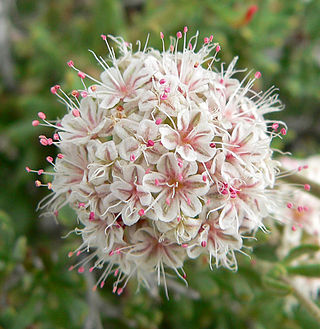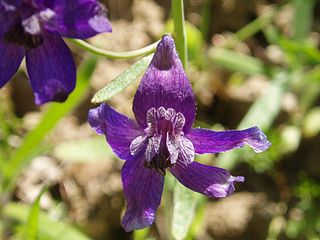
Delphinium is a genus of about 300 species of annual and perennial flowering plants in the family Ranunculaceae, native throughout the Northern Hemisphere and also on the high mountains of tropical Africa. The genus was erected by Carl Linnaeus.

Chlorogalum pomeridianum, the wavy-leafed soap plant, California soaproot, or Amole, is the most common and most widely distributed of the soap plants, soaproots or amoles, which make up the genus Chlorogalum of flowering plants. It is occasionally known as the "wild potato", but given the plant's lack of either resemblance or relationship to the potato, this name is not recommended.

Rubus parviflorus, commonly called thimbleberry, is a species of Rubus native to northern temperate regions of North America. The plant has large hairy leaves and no thorns. It bears edible red fruit similar in appearance to a raspberry, but shorter, almost hemispherical. It has not been commercially developed for the retail berry market, but is cultivated for landscapes.

Frangula californica is a species of flowering plant in the buckthorn family native to western North America. It produces edible fruits and seeds. It is commonly known as California coffeeberry and California buckthorn.

Delphinium luteum, known by the common name yellow larkspur, is a species of small perennial herb in the buttercup family bearing bright yellow cornucopia-shaped flowers. Endemic to the rocky, foggy hillsides of coastal Sonoma County, California, it is critically endangered, with about 200 individuals believed to be in existence as of 2005.

Calocedrus decurrens, with the common names incense cedar and California incense cedar, is a species of coniferous tree native to western North America. It is the most widely known species in the genus, and is often simply called incense cedar without the regional qualifier.

Papaver nudicaule, the Iceland poppy, is a boreal flowering plant. Equivalence with Papaver croceum has been contested. Native to subpolar regions of Asia and North America, and the mountains of Central Asia as well as temperate China, Iceland poppies are hardy but short-lived perennials, often grown as biennials, that yield large, papery, bowl-shaped, lightly fragrant flowers supported by hairy, 1 foot (30 cm) curved stems among feathery blue-green foliage 1-6 inches long. They were first described by botanists in 1759. The wild species blooms in white or yellow, and is hardy from USDA Zones 3a-10b.

Eriogonum fasciculatum is a species of wild buckwheat known by the common names California buckwheat and flat-topped buckwheat. Characterized by small, white and pink flower clusters that give off a cottony effect, this species grows variably from a patchy mat to a wide shrub, with the flowers turning a rusty color after blooming. This plant is of great benefit across its various habitats, providing an important food resource for a diversity of insect and mammal species. It also provides numerous ecosystem services for humans, including erosion control, post-fire mitigation, increases in crop yields when planted in hedgerows, and high habitat restoration value.

Vaccinium parvifolium, the red huckleberry, is a species of Vaccinium native to western North America.

Methyllycaconitine (MLA) is a diterpenoid alkaloid found in many species of Delphinium (larkspurs). In common with many other diterpenoid alkaloids, it is toxic to animals, although the acute toxicity varies with species. Early research was focused on identifying, and characterizing the properties of methyllycaconitine as one of the principal toxins in larkspurs responsible for livestock poisoning in the mountain rangelands of North America. Methyllycaconitine has been explored as a possible therapeutic agent for the treatment of spastic paralyses in man, and it has been shown to have insecticidal properties. Most recently, it has become an important molecular probe for studying the pharmacology of the nicotinic acetylcholine receptor.

Rubus ursinus is a North American species of blackberry or dewberry, known by the common names California blackberry, California dewberry, Douglas berry, Pacific blackberry, Pacific dewberry and trailing blackberry.

Delphinium cardinale is a species of larkspur known by the common names scarlet larkspur and cardinal larkspur. This wildflower is native to California and Baja California, where it grows on coastal, inland, and desert chaparral slopes, such as the Colorado Desert, and the Peninsular and Transverse Ranges. The presence of diterpenoid alkaloids, probably including the highly toxic methyllycaconitine, in above-ground parts of D. cardinale means that they are likely to be toxic if ingested.

Delphinium glaucum, known by the common names Sierra larkspur, mountain larkspur, and glaucous larkspur, is a species of wildflower in the genus Delphinium, which belongs to the buttercup family, Ranunculaceae. It is native to western North America from Arizona to Alaska, growing in moist mountainous environments such as riverbanks and meadows.

Delphinium variegatum is a species of larkspur known by the common name royal larkspur. It is endemic to California, where it grows in mountains, valley and coast in woodlands and grasslands. On the forest floor of California oak woodlands typical plant associates are Calochortus luteus, Cynoglossum grande and Calochortus amabilis.

Delphinine is a toxic diterpenoid alkaloid found in plants from the Delphinium (larkspur) and Atragene genera, both in the family Ranunculaceae. Delphinine is the principal alkaloid found in Delphinium staphisagria seeds – at one time, under the name stavesacre, a very well known herbal treatment for body lice. It is related in structure and has similar effects to aconitine, acting as an allosteric modulator of voltage gated sodium channels, and producing low blood pressure, slowed heart rate and abnormal heart rhythms. These effects make it highly poisonous. While it has been used in some alternative medicines, most of the medical community does not recommend using it due to its extreme toxicity.

Sambucus cerulea or Sambucus nigra ssp. cerulea, with the common names blue elderberry and blue elder, is a coarse textured shrub species of elder in the family Adoxaceae.

Purshia glandulosa is a species of flowering plant in the rose family known by the common names antelope bitterbrush, desert bitterbrush, Mojave antelope brush.

Delphinium tricorne, known by the common names dwarf larkspur or spring larkspur, is a species of flowering plant in the Ranunculaceae (buttercup) family. It is native to the central and eastern United States, where it is the most common Delphinium found.
This is a list of plants used by the indigenous people of North America. For lists pertaining specifically to the Cherokee, Iroquois, Navajo, and Zuni, see Cherokee ethnobotany, Iroquois ethnobotany, Navajo ethnobotany, and Zuni ethnobotany.

Delphinium barbeyi is a species of flowering plant in the buttercup family known by the common names subalpine larkspur, tall larkspur, and Barbey's larkspur. It is native to the interior western United States, where it occurs in the states of Arizona, Colorado, New Mexico, Utah, and Wyoming.



















